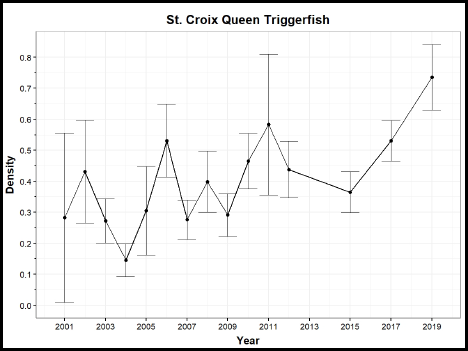- ABOUT US
- PROGRAM AREAS
- CONSERVATION APPROACH
- EDUCATION
- MULTIMEDIA
Independent Survey Data Improves Management of Caribbean Queen Triggerfish
Background:

Queen triggerfish is a Caribbean reef fish that is harvested by local fishermen and sold to restaurants and fish markets throughout the islands. Due to this demand and its importance to coral reef ecosystems, this fishery is managed in the U.S. Exclusive Economic Zone (EEZ) through a Fishery Management Council as established through the Magnuson-Stevens Fishery Conservation and Management Act. The Caribbean Fishery Management Council is responsible for the creation of management plans for fishery resources in the EEZ off Puerto Rico and the U. S. Virgin Islands, which is where queen triggerfish are harvested. The Council must determine what is an acceptable amount of fish to take out of the water each year. They do this by conducting a stock assessment. The stock assessment evaluates several factors that affect a fish population -- such as biology, reproduction, and fishing pressure -- to predict how the fish stock will respond to management actions, both currently and in the future.
The queen triggerfish stock assessment provided scientists in NOAA's Coral Reef Conservation Program (CRCP) and Southeast Fisheries Science Center (SEFSC) with an opportunity to apply independent survey data to a traditionally fisheries-dependent stock assessment.

Key messages:
Data from the CRCP's National Coral Reef Monitoring Program has been recommended for use in the queen triggerfish stock assessment. This is the first time that the CRCP's fisheries-independent data has been used in a Caribbean Fishery Management Council stock assessment. By using these data, a more accurate assessment can be made and it establishes a way for these data to be used in future stock assessments.
An important part of this process included combining historical and current datasets. A calibration study performed by scientists at the SEFSC allowed for the historic time series (2001-2015) collected with belt-transects to be used in the assessment with the newly collected Reef Visual Census stationary point count method data (2017-2019). By combining these datasets, it is now the longest fisheries-independent dataset being considered for use in the U.S. Caribbean. This approach can (and should) be used for future stock assessments.
References:
Grove, Laura Jay W., Jeremiah Blondeau, and Jerald S. Ault. 2022. Fishery-Independent Reef Fish Visual Survey Population Density and Length Composition for Queen Triggerfish in the U.S. Caribbean. SEDAR80-WP-08. SEDAR, North Charleston, SC. 32 pp.
Grove, Laura Jay W., Jeremiah Blondeau, and Jerald S. Ault. 2021. National Coral Reef Monitoring Program's Reef fish Visual Census Metadata for the U.S. Caribbean. SEDAR80-WP-02. SEDAR80, North Charleston, SC. 55 pp.
Related Stories and Products
About Us

The NOAA Coral Reef Conservation Program was established in 2000 by the Coral Reef Conservation Act. Headquartered in Silver Spring, Maryland, the program is part of NOAA's Office for Coastal Management.

The Coral Reef Information System (CoRIS) is the program's information portal that provides access to NOAA coral reef data and products.
Work With US
U.S. Coral Reef Task Force
Funding Opportunities
Employment
Fellowship Program
Contracting Assistance
Graphic Identifier
Featured Stories Archive

Access the archive of featured stories here...
Feedback
Thank you for visiting NOAA’s Coral Reef Conservation Program online. Please take our website satisfaction survey. We welcome your ideas, comments, and feedback. Questions? Email coralreef@noaa.gov.
Stay Connected
Contact Us
NOAA’s Coral Reef Conservation Program
SSMC4, 10th Floor
1305 East West Highway
Silver Spring, MD 20910
coralreef@noaa.gov
